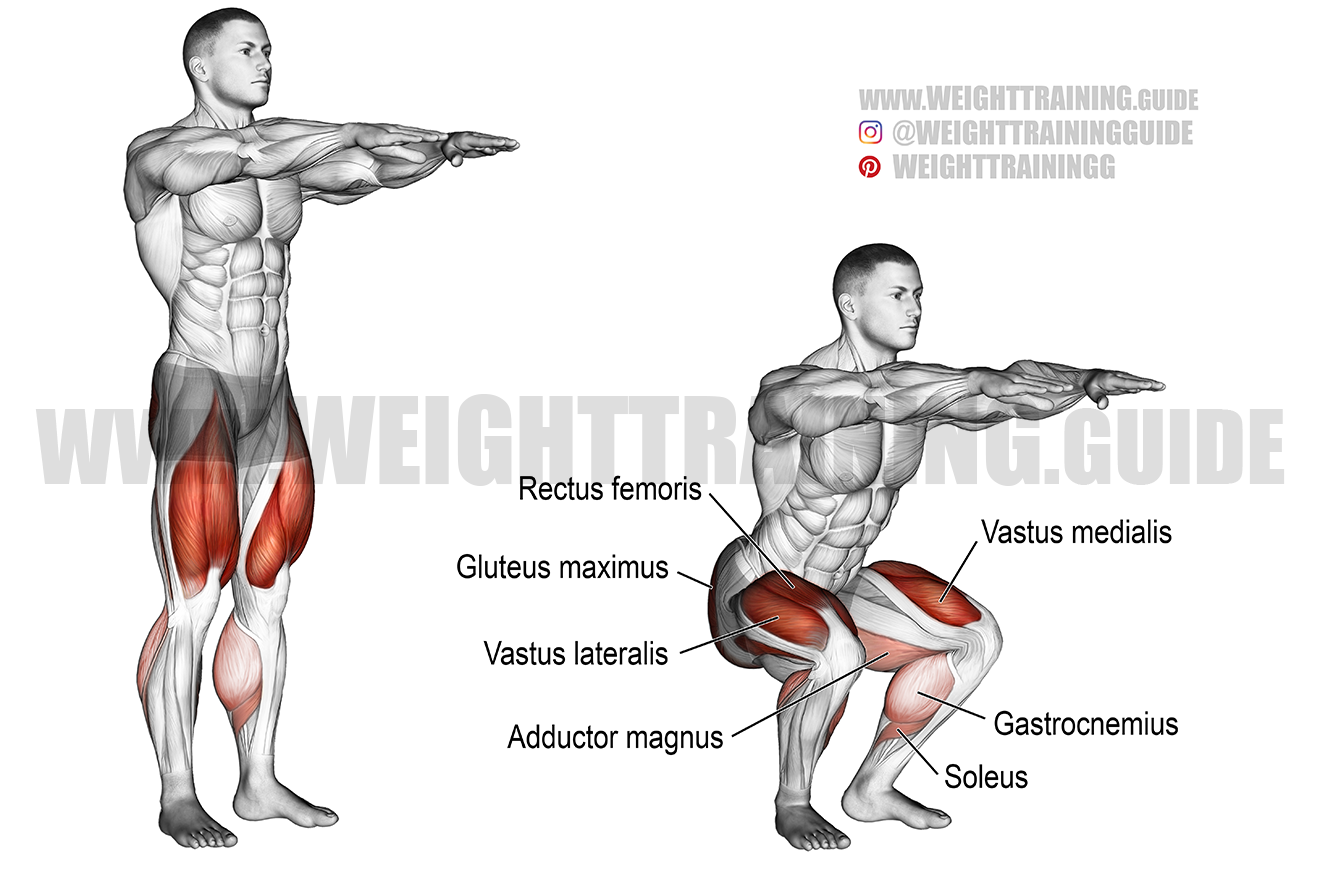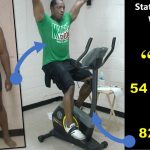Are you looking to elevate your fitness routine without the need for fancy equipment or a gym membership? Squat bodyweight exercises might just be the perfect solution for you.
These exercises are more than just a workout; they’re a powerful tool to build strength, improve flexibility, and boost your overall health. Imagine being able to achieve your fitness goals from the comfort of your own home, with exercises that adapt to your level and grow with you.
Intrigued? Keep reading to discover how squat bodyweight exercises can transform your fitness journey and why they should be a staple in your workout regimen.

Credit: www.youtube.com
Benefits Of Bodyweight Squats
Bodyweight squats are a versatile exercise that offers numerous benefits. They require no equipment, making them perfect for home workouts. Squats target multiple muscle groups, enhancing strength and endurance. They improve balance and posture, contributing to overall well-being. Discover the advantages of incorporating bodyweight squats into your fitness routine.
1. Strengthens Lower Body MusclesBodyweight squats focus on your legs and glutes. They build strength in your thighs and calves. Regular squatting tones and shapes your lower body.
2. Enhances Flexibility and MobilitySquats stretch and activate your leg muscles. This improves flexibility and range of motion. Better mobility helps with daily activities and reduces injury risk.
3. Improves Balance and CoordinationSquatting engages your core and stabilizing muscles. This boosts balance and coordination. Enhanced balance aids in performing other exercises safely.
4. Promotes Better PostureBodyweight squats strengthen the back and core. Stronger muscles support better posture. Improved posture reduces back pain and discomfort.
5. Burns Calories and Aids Weight LossSquats are an effective calorie-burning exercise. They increase your heart rate and metabolism. Regular squats help with weight management.
6. Convenient and AccessibleNo equipment needed for bodyweight squats. You can do them anywhere. This makes squats a convenient fitness choice.
Proper Squat Form
Squat bodyweight exercises are a staple in fitness routines. Performing squats with proper form is essential. It enhances muscle engagement and prevents injuries. Understanding the key aspects of proper squat form is crucial. Let’s explore the vital components of a good squat.
Stance And Foot Position
Your stance forms the foundation of your squat. Stand with feet shoulder-width apart. Point your toes slightly outward. This position provides stability and balance. It allows for a more comfortable squat. Ensure your weight is distributed evenly. Do not lean forward or backward.
Knee And Hip Alignment
Proper alignment protects your joints. Keep knees in line with your toes. Do not let them cave inward. Maintain a straight path as you lower. Bend your hips back first, then your knees. This sequence prevents undue stress on your knees. It helps in maintaining balance.
Core Engagement
A strong core is vital during squats. Engage your abdominal muscles throughout the movement. This engagement supports your spine. It aids in maintaining an upright posture. Keep your chest up and shoulders back. Avoid rounding your back at all costs.
Types Of Bodyweight Squats
Bodyweight squats offer a versatile workout option. They can be done anywhere. Different types target various muscle groups. This variety keeps your routine interesting. Let’s explore some popular bodyweight squat variations.
Basic Squat
The basic squat is a foundational exercise. Stand with feet shoulder-width apart. Bend your knees and lower your hips. Keep your back straight. Return to standing position. This squat works the quadriceps, hamstrings, and glutes.
Sumo Squat
The sumo squat targets the inner thighs. Stand with feet wider than shoulders. Point your toes outward. Bend your knees and lower your hips. Keep your chest up. Return to the starting position. It enhances flexibility and strength.
Jump Squat
The jump squat adds a cardio element. Start in a basic squat position. Explode upwards into a jump. Land softly and return to squat position. It builds power and endurance. Great for burning calories quickly.
Pistol Squat
The pistol squat is a challenging single-leg squat. Stand on one leg. Extend the other leg forward. Lower your body into a squat. Keep your balance. Rise back up to standing. This squat requires strength and coordination.
Credit: workoutlabs.com
Incorporating Squats In Your Routine
Squats are a fundamental part of fitness routines. They target multiple muscle groups. Squats enhance strength and balance. Incorporating squats in your routine can be beneficial. They boost your workout efficiency. Squats can be done anywhere. No equipment needed. Add them to your daily exercise plan.
Warm-up Exercises
Start with a proper warm-up. It prepares your body for squats. Do dynamic stretches. Leg swings and arm circles are good options. They increase blood flow. Warm muscles are less prone to injury. Spend at least five minutes warming up. Focus on your legs and hips. This ensures readiness for squats.
Repetitions And Sets
Decide your repetitions and sets. Beginners should aim for fewer reps. Three sets of ten squats is a good start. Increase reps as you gain strength. Track your progress weekly. Adjust your sets accordingly. Consistency is key. Regular practice enhances endurance and form.
Combining With Other Exercises
Mix squats with other exercises. Create a balanced workout routine. Add lunges and planks to your session. They complement squats well. This combination targets different muscle groups. It boosts overall fitness. Alternate between these exercises. It keeps your routine engaging. Avoid doing the same moves daily. Variety prevents boredom.
Common Mistakes To Avoid
Poor form in squat exercises leads to strain. Avoid leaning forward excessively; it increases injury risk. Keep knees aligned with feet to prevent stress.
Mastering squat bodyweight exercises can be a game-changer for your fitness routine. Yet, many people unknowingly make common mistakes that hinder their progress. Understanding these pitfalls can help you refine your technique and achieve better results. Let’s dive into some of the most frequent errors and learn how to avoid them.Incorrect Knee Position
Your knees play a crucial role in the squat movement. A common mistake is allowing the knees to cave inward as you squat. This not only reduces the effectiveness of the exercise but also increases the risk of injury. Keep your knees aligned with your toes. Imagine there’s a string pulling them outward. This will engage your muscles correctly and protect your joints.Neglecting Core Stability
Core stability is often overlooked during squats. Without a strong core, you can lose balance and strain your back. This compromises the quality of your workout. Engage your core by tightening your abdominal muscles. Think of bracing your stomach as if you’re about to be punched. This will provide a solid foundation for your squat.Poor Depth Control
Depth is key to maximizing the benefits of squats. Some people squat too shallow, missing out on full muscle engagement. Others go too deep, sacrificing form and risking injury. Aim to squat until your thighs are parallel to the ground. This is a sweet spot where you maximize muscle activation while maintaining control. Test your depth by squatting in front of a mirror to ensure accuracy. Remember, it’s the small tweaks that make a big difference. Have you noticed any of these mistakes in your routine? Adjusting them might be the breakthrough you need to elevate your squat game.
Credit: workoutlabs.com
Progression And Variations
Squat bodyweight exercises are a fantastic way to build strength and improve mobility without needing fancy equipment. As you get comfortable with basic squats, it’s important to challenge yourself with progression and variations. This keeps your workouts exciting and helps you continue building muscle. But how do you do this effectively without compromising form or risking injury?
Adding Resistance
To add resistance, start by using household items like a backpack filled with books. This simple change can make a big difference in your workout intensity. As you advance, you might invest in a pair of dumbbells or a resistance band. These tools not only add weight but also engage different muscle groups. How much resistance should you add? Just enough to feel challenged without losing your form.
Tempo Variations
Changing the speed of your squats can be a game-changer. Try slowing down the descent or adding a pause at the bottom. This increases muscle tension and builds endurance. You can also speed up your squats for a cardio boost. Find a tempo that challenges you but still allows you to maintain balance. Have you ever tried counting to three during the lowering phase? It’s harder than it sounds!
Advanced Techniques
Once you master the basics, it’s time to explore advanced techniques. Consider single-leg squats or pistol squats if you’re feeling adventurous. These require balance and strength, making them a great test of your abilities. You can also experiment with jump squats to add a plyometric element to your routine. Remember, advanced doesn’t mean complicated. Focus on form, and the results will follow.
Progressing in squat exercises is not just about getting stronger; it’s about keeping your workouts fresh and engaging. Why stick to the same routine when small tweaks can lead to big gains? Push your limits and enjoy the journey!
Tracking Progress
Tracking progress in squat bodyweight exercises boosts motivation and highlights improvement. Regularly record reps and sets to measure growth. Adjust intensity and challenge yourself to reach new fitness goals.
Tracking progress in squat bodyweight exercises is crucial for keeping your fitness journey on track. It allows you to see how far you’ve come and what you need to focus on next. It’s not just about getting stronger; it’s about understanding your growth and making adjustments to achieve your goals. Let’s dive into how you can effectively track your progress and keep pushing your limits.Setting Goals
Setting clear, achievable goals is the first step in tracking your progress. Ask yourself, what do you want to accomplish with your squat exercises? Is it improving your form, increasing your repetitions, or enhancing your overall strength? Write down your goals. Make them specific and time-bound. Instead of saying “I want to do more squats,” aim for “I want to do 50 squats in two weeks.” This clarity will keep you motivated and focused. Reflect on why these goals matter to you personally. This will help you stay committed when challenges arise. It’s your journey, make it meaningful.Monitoring Improvements
Tracking improvements is key to understanding your progress. Start by keeping a workout journal. Note down how many squats you do each session, along with any changes in form or endurance. Take weekly photos or videos. They provide visual proof of your progress and help in correcting your posture. Celebrate small victories. If you’ve added just a few more squats than last week, that’s progress. Remember, consistency is more impactful than dramatic changes.Adjusting Challenges
As you progress, your body adapts. It’s time to adjust the challenges. Are you still finding your routine tough, or has it become too easy? Increase the difficulty by adding variations. Try squats with a pause or incorporate jumping squats. This keeps your muscles engaged and growing. Ask yourself, are you pushing hard enough? Sometimes, we underestimate our capabilities. Challenge yourself a bit more each week. Your body will thank you for it. Tracking progress isn’t just a task; it’s an exciting part of your fitness journey. So, how will you make the most of it?Health And Safety Considerations
Squat bodyweight exercises require attention to posture and technique to prevent injuries. Ensuring your knees stay aligned with your feet is crucial. Maintaining a straight back helps avoid strain and enhances effectiveness.
### Health and Safety Considerations Engaging in squat bodyweight exercises is a fantastic way to build strength and improve fitness. However, maintaining your health and safety is paramount. Understanding the right techniques and precautions can prevent unnecessary injuries. Let’s delve into key considerations that will keep your workouts safe and effective.Listening To Your Body
Your body is an excellent communicator. Pay attention to any signals of pain or discomfort during exercises. If you experience sharp pain, stop immediately and assess your form. Ignoring these signals can lead to injuries that may sideline your fitness journey. Remember, it’s better to be cautious than to push through and risk harm. Trust your instincts. If something doesn’t feel right, it probably isn’t. Adjust your movements and ensure you’re performing exercises correctly.Preventing Injuries
Proper form is essential in preventing injuries. Keep your back straight and knees aligned over your toes during squats. Warm up before starting your routine. This increases blood flow and prepares your muscles for the workout. Stay consistent but avoid overtraining. Your muscles need time to recover. Balance your workouts with rest days to enhance muscle growth and prevent fatigue.Consulting Professionals
Seek guidance from fitness professionals if you’re new to squat exercises. They can provide valuable insights into proper form and technique. A personal trainer can tailor a workout plan specific to your needs and fitness level, ensuring you progress safely. Consult a healthcare provider if you have existing health conditions. They can advise on whether squat exercises are suitable for you and suggest modifications if needed. Prioritizing these health and safety considerations will make your squat workouts more effective and enjoyable. Are you ready to squat your way to a healthier you?Frequently Asked Questions
What Are Squat Bodyweight Exercises?
Squat bodyweight exercises are movements that utilize your body’s weight for resistance. They target the lower body, including the glutes, quads, and hamstrings. These exercises improve strength, flexibility, and balance without the need for equipment. Perfect for home workouts, they are versatile and can be performed anywhere.
How Do Squats Benefit Your Body?
Squats enhance muscle strength, improve flexibility, and boost core stability. They engage multiple muscle groups, promoting better posture and balance. Regular squatting can increase overall fitness and contribute to weight management. Additionally, squats help in building endurance and developing a stronger lower body.
Can Beginners Do Squat Exercises?
Yes, beginners can safely perform squat exercises. Start with basic squat variations to learn correct form and technique. Gradually increase intensity and duration as strength improves. Focus on maintaining proper posture and alignment to avoid injury. Squats are adaptable and can be tailored to suit any fitness level.
How Often Should You Do Squats?
Perform squats 2-3 times weekly for optimal results. Allow rest days to enable muscle recovery and growth. Adjust frequency based on personal fitness goals and experience level. Consistency and proper technique are key to maximizing the benefits of squat exercises.
Listen to your body to prevent overtraining.
Conclusion
Squat bodyweight exercises offer many benefits. They strengthen muscles and improve balance. No equipment needed. Perfect for beginners and experts alike. Try variations for different challenges. Squats boost endurance and flexibility. They fit into any routine. Easy to modify based on fitness level.
Consistency brings results. Regular practice enhances performance. It supports joint health and posture. Squats help in daily movements. So, keep squatting and stay active. Every rep counts towards a healthier you. Enjoy the journey of building strength. Your body will thank you.
{ “@context”: “https://schema.org”, “@type”: “FAQPage”, “mainEntity”: [ { “@type”: “Question”, “name”: “What are squat bodyweight exercises?”, “acceptedAnswer”: { “@type”: “Answer”, “text”: “Squat bodyweight exercises are movements that utilize your body’s weight for resistance. They target the lower body, including the glutes, quads, and hamstrings. These exercises improve strength, flexibility, and balance without the need for equipment. Perfect for home workouts, they are versatile and can be performed anywhere.” } } , { “@type”: “Question”, “name”: “How do squats benefit your body?”, “acceptedAnswer”: { “@type”: “Answer”, “text”: “Squats enhance muscle strength, improve flexibility, and boost core stability. They engage multiple muscle groups, promoting better posture and balance. Regular squatting can increase overall fitness and contribute to weight management. Additionally, squats help in building endurance and developing a stronger lower body.” } } , { “@type”: “Question”, “name”: “Can beginners do squat exercises?”, “acceptedAnswer”: { “@type”: “Answer”, “text”: “Yes, beginners can safely perform squat exercises. Start with basic squat variations to learn correct form and technique. Gradually increase intensity and duration as strength improves. Focus on maintaining proper posture and alignment to avoid injury. Squats are adaptable and can be tailored to suit any fitness level.” } } , { “@type”: “Question”, “name”: “How often should you do squats?”, “acceptedAnswer”: { “@type”: “Answer”, “text”: “Perform squats 2-3 times weekly for optimal results. Allow rest days to enable muscle recovery and growth. Adjust frequency based on personal fitness goals and experience level. Consistency and proper technique are key to maximizing the benefits of squat exercises. Listen to your body to prevent overtraining.” } } ] }




